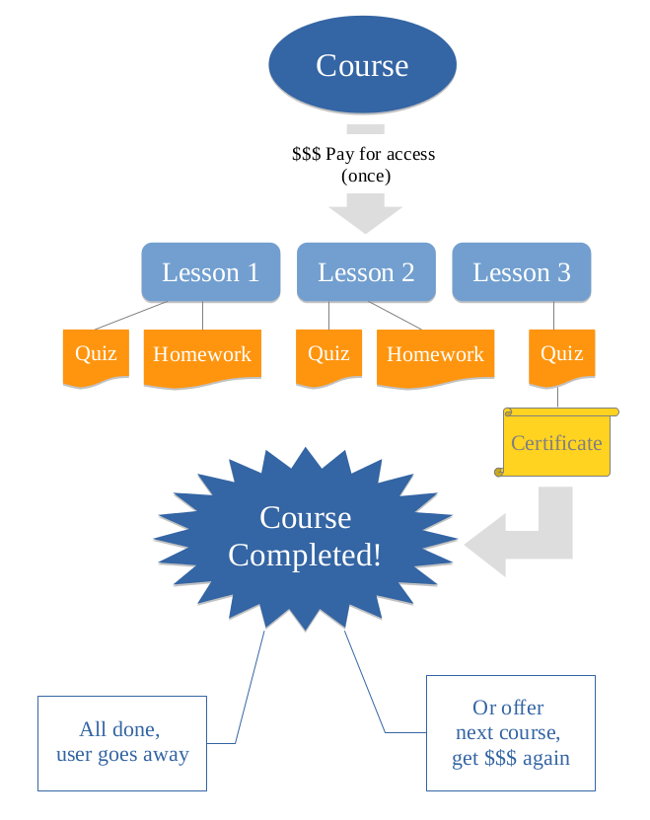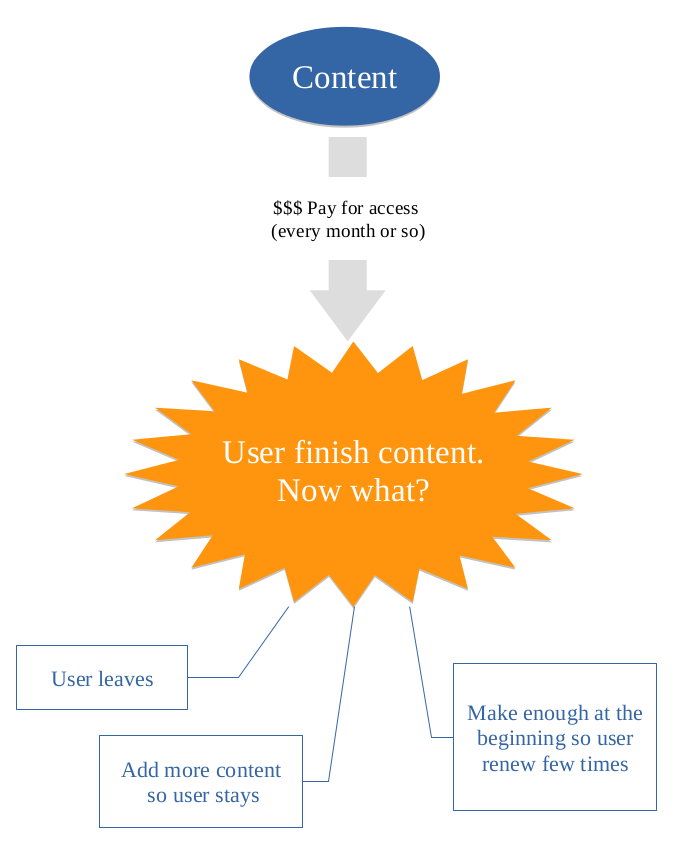How To Create a Paid Course in WordPress
Using WordPress Plugins To Make Money From Your Knowledge
Do you have specific knowledge that you want to monetize by publishing paid courses? WordPress makes this quite easy. The problem is only that it's easy to get lost in the many options. This guide will make things easier for you. It will show you what kind of plugins you need to use and how to make them work together. It's short, I promise.
Do I need LMS Plugin or Membership Plugin?
There are two main ways to handle a paid course in WordPress - by using a Learning Management System (LMS) or by using a Membership Plugin. Both are similar. Some LMS plugins include some membership functionality and some membership plugins include kind-of LMS features. So it's hard to choose. Let me tell you the main and most important difference between both:
LMS usually assume that you will want to charge once for completing a course. Membership plugins usually assume that your users will stay longer and pay for monthly access.
LMS Plugin

- More work at the beginning
- Hands-free after that (maybe)
- Better customer satisfaction (maybe)
Membership Plugin

- Less work at the beginning, quick start
- You need to add content all the time
- More $$$ because of recurring payments (maybe)
Completing a course is one-time act. You can even issue certificate or badge when it's done (possible with some plugins). On the other hand building a membership site means your users will use the information longer time and there is usually no "completion" until they simply lose interest or feel they mastered it all.
The difference is never as sharp however because many plugins include functions from both worlds. Using LMS plugin is often better because you can break your learning material in modules (courses). Then have the users pay for each course as them move from one module to the next one. Or have some free courses and some paid ones. Huge flexibility. But with membership plugin you can have them pay every month without bothering to have more "courses".
At the end it comes to what exactly you want to teach. If you want to teach driving theory online, you probably need LMS. Create the course, have exam, finish, give certificate.
A web marketing course on the other hand may be better done as ongoing subscription since you can constantly add new material. Membership plugins make it easier to do these kind of things.
LMS plugins integrate better with quizzes, assignments, and so on. And most of them can tie completing a course or lesson to completing a quiz or assignment. So if you want to put your users to test and give some kind of assurance they learned the material, you need LMS system.
Finally, don't forget you can use both options together. You can charge for monthly-based access to your courses through membership plugin and leave the rest of the work to the LMS. This is perfectly possible with Namaste! LMS and any membership plugin.
Some LMS Plugins to Consider
Because we are the developers Namaste! LMS it's natural to recommend it. Namaste! LMS is free, connects to the best exam / quiz plugin, gives super-high flexibility options, assignments, gradebook, certificates - possibly everything you may need.
Some other LMS plugins worth a look are:
- WP Courseware - probably the oldest LMS plugin, costs $67 - $137.
- WooThemes Sensei - supported by the huge Woothemes network. In case you use some of their other products, this might be the best choice. $129 - $279.
- WP TrainUp - our best competitors. Although not free, it's modestly priced - £45. This is also the most developer-friendly plugin along with Namaste! LMS.
- Docebo is maybe the most feature rich but it's cloud-based. There is a steep recurring monthly fee starting at $170.
Some of the plugins do all in one while others (like Namaste! LMS) integrate with other WordPress plugins. Both approaches have their advantages and disadvantages.
Membership Plugins to Consider
There are of course many others. Here are the most interesting ones:
- Membership & Content Restriction – Paid Member Subscriptions is an easy to use membership plugin that can be used also to protect content from Namaste! LMS.
- Magic members is another easy one although it costs more.
- S2Member is developer-friendly and big in functions. The prices are also fair.
- Paid Membership PRO starts with a free version, next one is $97. This is a good and stable plugin.
- Memberpress is probably the most feature-rich. It comes with yearly fee however.
Quizzes / Exams
Often you'll want your users to pass some quizzes or exams to ensure they have learned the material. If you go the LMS-plugin route you can connect the successfully completed quiz to completion of lesson or course. Otherwise (the membership-plugin route) you can use the quiz just as self-assessment tool. With quiz plugin like WatuPRO you can assign certificates and badges regardless what kind of membership or LMS plugin you use for the rest. You can even make everything free and only the exam paid.
Tutorials
Although WordPress content area is rich enough, sometimes you may want to publish content arranged as step-by-step guides and tutorials. You can use plugins like Step by Step, Daskal or Instruct. None of them integrates with LMS at this time (there are plans for Daskal to integrate with Namaste! LMS), so if you use them, you need a membership plugin for the payment part.
Badges and Levels
It's a wise idea to assign badges for completing various actions. The easiest solution here is provided by some of the paid LMS plugins and by the WatuPRO Play plugin. Another option here is to use BadgeOS. This is a super powerful plugin. Its complexity is the reason I have not found a good use of it yet.
You can perfectly go without such things in your course. But I think if you add them, you'll increase the interest and customer satisfaction.
Discussion and Feedback
Finally it's useful to allow some discussion in the learning process, or at least to obtain user's feedback. There are too many plugins to mention here, so I'd rather stick to giving you more general ideas:
- A contact form is obvious must-have
- Think about enabling comments. Plugins like Namaste! LMS (through the Connect module) allow users to submit comments on assignments etc.
- Adding a forum can be a very good option if you can handle the beginning stage. A stale empty forum is not good for you - you will need to fill it with content in the beginning and get the discussion going.
- Various rating widgets can come handy, just think twice if you want the ratings visible to everyone.
Conclusion
I hope this guide helps you to understand the difference between the most important groups of plugins. Essentially creating a paid course comes down to these few steps:
- Install LMS or membership plugin
- Create payment plans or prices for courses, exams etc.
- Create your content
- Start selling
At the end, steps 3 and 4 are likely to cost you more in time and/or money than step 1 and 2.